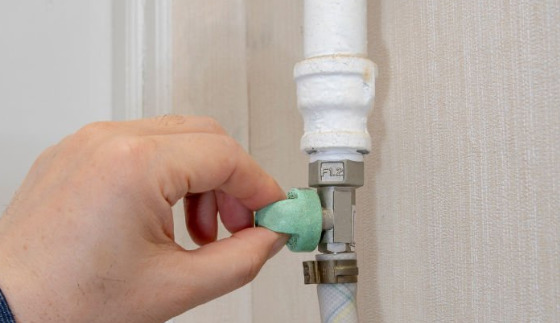Have you ever found yourself standing in front of your bathroom sink, frustrated and perplexed as to why it just won’t drain? Despite clear pipes, the water stubbornly refuses to go down. It’s like trying to solve a mystery with no clues. But fear not! In this article, we will unravel the enigma and shed light on the common causes behind this frustrating issue. By following our step-by-step troubleshooting guide and implementing effective solutions, you’ll have your bathroom sink flowing smoothly once again, ensuring a safe and worry-free environment.

Common Causes for No Hot Water in Bathroom Sink
If you’re experiencing no hot water in your bathroom sink, there are several potential causes to consider.
Faulty faucet cartridge
A faulty cartridge can cause low water pressure or leaks. To diagnose faucet issues, check for any visible signs of damage or wear on the cartridge.
Blocked pipes or valves

Check for any visible blockages or obstructions in your pipes or valves that may be causing the issue with your bathroom sink not draining properly. Here are some important things to consider:
Blocked Pipes:
- Hair, soap scum, and toothpaste can build up in pipes and cause blockage.
- Try running hot water or a baking soda and vinegar mixture to unclog pipes.
Valve Maintenance:
- Check shut-off valves for any issues.
- Consider having a professional inspect the system to determine the core issue.
Remember to prioritize safety when dealing with plumbing repairs and water pressure issues.
Sediment buildup in water heater
One possible cause of sediment buildup in your water heater could be mineral deposits from hard water. These deposits can accumulate over time and lead to scale buildup, which can reduce the efficiency and lifespan of your water heater. To prevent scale buildup and ensure optimal performance, regular descaling techniques should be employed. This includes flushing out the tank to remove sediment, using descaling agents, or installing a water softener system. Regular maintenance is crucial for maintaining a safe and efficient water heater.
Diagnosing the Problem

When diagnosing the problem of no hot water in your bathroom sink, there are a few initial checks and observations you should make.
Initial checks and observations
Before calling a pro plumber, make sure the anti-scald device in your bathroom sink isn’t set too high.
Diagnosing symptoms: no hot water, clogged plumbing, low pressure, airlock, frozen pipes.
Tools and equipment needed for diagnosis
Now that you have made some initial checks and observations, it’s time to gather the necessary tools and equipment for a proper diagnosis. To troubleshoot the issue with your bathroom sink, you will need diagnostic equipment such as a flashlight, plunger, drain snake, and a wrench. These tools will help you inspect the plumbing system, identify any clogs or blockages, and determine the root cause of the problem.
Safety precautions to consider
To ensure your safety, be sure to wear protective gloves and eyewear when working with plumbing systems. Safety precautions to consider include:
Preventive measures:
- Regularly inspect and maintain plumbing fixtures and pipes.
- Use drain covers to prevent debris from clogging the drains.
Proper maintenance:
- Keep flammable materials away from plumbing systems.
- Follow manufacturer’s instructions for any chemicals used in cleaning or unclogging pipes.
Potential hazards can arise when working with plumbing systems, so it is important to take these safety precautions seriously.
Step-by-Step Troubleshooting Guide
When you’re experiencing no hot water in your bathroom sink, there are a few key points to consider before troubleshooting further.
Checking the faucet
Check if the hot water is flowing properly by turning on the faucet in your bathroom sink. To troubleshoot faucet issues and identify problems, follow these steps:
- Test hot water flow:
- Is the water coming out of the faucet at a consistent temperature?
- Does the flow of hot water match that of cold water?
- Check faucet functionality:
- Is there any leakage from the faucet?
- Can you easily turn the handle to adjust the water temperature?
Inspecting the water heater
If you notice any issues with your hot water, one thing you can do is inspect the water heater. Evaluating the water heater is crucial for troubleshooting common water heater problems. Make sure to check for leaks, rust, or corrosion on the tank and connections. Additionally, ensure that the temperature and pressure relief valve is functioning properly. It’s also important to maintain the water heater by flushing out sediment regularly and checking the anode rod for signs of wear.
Evaluating the plumbing lines
To evaluate the plumbing lines, take note of any visible blockages or signs of corrosion in the pipes. Ensure safety by measuring water pressure and checking for leaks. Evaluate pipe size to ensure optimal water flow. Examine water flow in each fixture to identify any issues. Consider consulting a professional plumber if necessary. Remember, maintaining proper plumbing is crucial for the safety and functionality of your bathroom sink.
Solutions and Fixes
If you are experiencing issues with your bathroom sink, there are several common problems that could be causing it.
Replacing a faulty faucet cartridge
When replacing a faulty faucet cartridge, make sure to turn off the water supply before starting the process. To replace the cartridge, follow these steps: – First, remove any decorative caps or handles covering the cartridge. – Use a screwdriver to unscrew and remove the handle. – Next, locate the retaining nut and use pliers to loosen and remove it. – Gently pull out the old cartridge and insert the new one in its place. – Finally, reassemble the handle and turn on the water supply to check for any leaks or issues with water pressure.
Clearing blockages in pipes

You can try using a plunger to clear blockages in your pipes. To clear blockages safely, start by creating a tight seal around the drain with the plunger. Then, vigorously plunge up and down for about 20 seconds. Repeat this process several times if necessary. If the blockage persists, consider using effective drain cleaning methods like a plumbing snake or chemical drain cleaner. To prevent future clogs, avoid flushing items that can cause blockages and regularly clean your drains. If all else fails, it’s best to seek professional plumbing assistance for safe and thorough clearing of blockages in your pipes.
Addressing sediment buildup
When it comes to addressing sediment buildup in your bathroom sink, there are a few cleaning techniques you can use to prevent blockages and ensure proper drainage. Here are some maintenance tips to help you keep your sink clear:
- Regularly clean the sink drain using a solution of hot water and vinegar.
- Pour boiling water down the drain followed by half a cup of vinegar.
- Let it sit for 10 minutes, then flush with hot water.
- Use a plunger or plumbing snake to remove any stubborn sediment or debris.
Prevention and Maintenance
Regular inspection routines
To ensure the proper functioning of your plumbing system, it is recommended to incorporate regular inspection routines into your maintenance schedule. This will help prevent future issues and ensure the safety of your home. Here are some maintenance tips to follow:
- Schedule professional plumbing services annually for a thorough inspection.
- Regularly check for leaks or unusual sounds in your plumbing system.
Cleaning and descaling techniques
If you’re experiencing issues with water flow or blockages in your bathroom sink, it may be helpful to learn some cleaning and descaling techniques. To remove limescale and prevent clogs, start by pouring a mixture of hot water and vinegar down the drain. Let it sit for a few minutes before flushing with hot water. For stubborn limescale, use a brush or cloth soaked in vinegar to scrub the affected area. Regularly cleaning your sink will help maintain proper water flow and prevent future blockages.
Importance of professional plumbing check-ups
Regular professional plumbing check-ups are important to ensure the proper functioning and longevity of your home’s plumbing system.
The importance of regular maintenance:
- Detect potential issues before they become major problems.
- Prevent costly repairs and water damage
Potential risks of DIY repairs:
- Lack of expertise can lead to further damage.
- Safety hazards if not done correctly
Benefits of professional expertise:
- Trained plumbers can identify hidden issues.
- Provide accurate solutions for long-lasting results
Cost effective prevention strategies:
- Regular maintenance helps avoid expensive repairs.
- Proactive measures save money in the long run
When to Call a Professional

If you’re facing issues with your bathroom sink that go beyond simple DIY fixes, it might be time to call a professional plumber.
Signs that it’s beyond a DIY fix.
When multiple bathrooms in your home are experiencing low hot water pressure, it may be a sign that the issue is beyond a DIY fix and requires professional assistance. Hiring a professional plumber is essential to address potential plumbing issues. If left unattended, these problems can lead to extensive repairs needed and long term damage. A professional plumber will have the expertise to accurately diagnose the problem and provide effective solutions, ensuring the safety of your home’s plumbing system.
Cost considerations and estimates
Breakdown of Average Prices for Drain Cleaning Depending on the Location of the Clog:
Toilet: $110–$275
Kitchen sink: $110–$215
Bathtub or shower: $225
Sewage main line: $100–$800
Source: Angi
To accurately determine the cost of professional plumbing assistance, you should contact a few different plumbers for estimates. When considering the cost, it is important to factor in the time estimates provided by the professionals. DIY options may seem more cost-effective initially, but they can lead to further complications and safety risks if not done correctly. Professional services ensure that the job is done properly and efficiently, prioritizing your safety and preventing potential damage to your home.
Conclusion
So there you have it, the mystery of why your bathroom sink isn’t draining despite having clear pipes has been solved. After a thorough examination of the possible causes, including an anti-scald device set too high, clogged plumbing, low hot water pressure, airlock, or frozen pipes, we have provided step-by-step troubleshooting guides and solutions to help you fix the issue. Remember to always practice proper prevention and maintenance to avoid future problems. However, if all else fails and you’re still facing drainage issues, don’t hesitate to call a professional for assistance. As they say, “An ounce of prevention is worth a pound of cure.”

